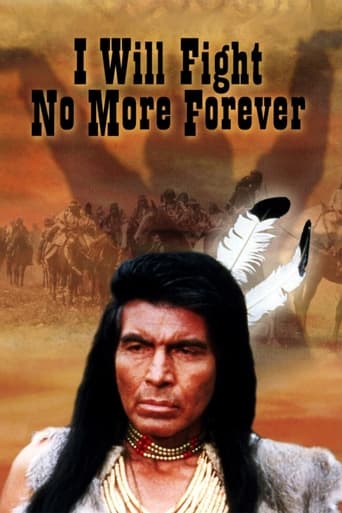Lee Eisenberg
Two years before producing "Roots", David Wolper turned out another fine production for TV. The Emmy-nominated "I Will Fight No More Forever" looks at Chief Joseph of the Nez Perce. Joseph led the resistance to the US's seizure of indigenous land. A general with whom Joseph was friendly told the Nez Perce to move to a reservation in Idaho. Joseph tried to move his people to safety, but due to the US army's superior weaponry and the lack of help from other groups of Indians, the Nez Perce eventually gave up fighting and Joseph made his famous pronouncement.It was appropriate that this movie aired during the time of the American Indian Movement. Indeed, it was in 1975 that Leonard Peltier got arrested. This was one of the many productions - whether for cinema or TV - that said that the US was finally taking a critical look at its history. Ned Romero turns in a fine performance as Joseph, as do James Whitmore as the general and Sam Elliott as his captain. I recommend it.
weezeralfalfa
As acknowledged by various others, this is a very well acted dramatization of the last major battle campaign in the long 'Indian Wars' between the US army or other military organizations and various Native American tribes or confederations. scattered over the American West. Although some of the details may have been altered, it provides a generally accurate picture of the effort of the US army to compel a segment of Native Americans to abandon their traditional home territory and way of life and accept a much inferior life on some much inferior shrunken territory. The banter between James Whitmore, as General Howard, and his subordinate Captain Wood(Sam Elliott), between Whitmore and Ned Romeo, as Chief Joseph, and between various Nez Perce chiefs, provides an intimate view of the conflicts between and within the key personalities in this saga. One-armed, ex-Civil War officer, Howard is portrayed as the ideal army leader in the western theater of the times, charged with a policing function between the Native Americans and settlers/prospectors, as well as enforcing government dictates regarding Native Americans. Unfortunately, his new distasteful function of enforcing the dictate that the Nez Perce leave their home territory conflicts with his former friendly relationship with the Nez Perce.The film dramatizes the transformation of chief Joseph as a reluctant advocate of accepting the dictate to move to a reservation, into a skilled military leader in attempting to find a refuge, probably in Canada, where his people could continue their traditional life. Unfortunately, the US federal government is unwilling to allow his group to make this journey to Canada, resulting in a masterful long chase through several states or territories, which occupies much of the film. General Howard is much criticized by the public and army superiors for his inability to capture Joseph's rather small band. Finally, apparently cornered short of his goal, Joseph decides further resistance is futile, and delivers his famous capitulation speech to the assembled army leaders. Although he was speaking on behalf of his group, in effect, he was speaking for all Native Americans.We may think of Chief Joseph as the Nez Perce equivalent of the much celebrated Lakota chief Red Cloud, and the great Comanche leader Quanah Parker. All 3 men were recognized as skilled military leaders, repeatedly thwarting attempts by the US army to 'tame' them. Yet, eventually, all 3 realized that further resistance was suicidal, and led the effort to accommodate their people to reservation life. By way of historical background, the Nez Perce actually had long been the chief Native American allies of Europeans in the region of NE Oregon, SW Washington, and adjacent Idaho during the wars with a confederation of most of the other anti-reservation regional tribes two decades earlier, as dramatized in the earlier Hollywood film "Pillars of the Sky", presently available at YouTube, as well as a DVD. Unlike that film, the present film doesn't incorporate a phony European woman as a love interest/conflict. Chief Joseph's wife is the only woman occasionally featured. The present film is now available on a DVD of several films featuring Sam Elliott.
monkeyface_si
Like its hero, Chief Joseph of the Nez Pierce, this movie uses understatement to incredible effect. Ned Romero is brilliant as Chief Joseph, under who attempted to take his tribe to Canada. James Whitmore is marvelous as the Army officer, with an unusually progressive outlook, but powerless to assist Chief Joseph.The photography is exceptional, and the score is hauntingly beautiful. See it if you can.
Hans-Dieter Seidensticker
I have seen this movie in 1978 for the first time and it has moved and inspired me a lot. Its plain and simple authenticity, its well-structured plot, its reliance on Joseph's best oratory and the excellent performances of the players who mostly do without histrionics have struck me at first sight and still do so. I will show this movie again tonight to a course of my college students who study Native American history and Indian oratory and customs to deepen their cross-cultural understanding and I am sure that they will be amazed again as quite a lot of other courses before. I can truly recommend this movie to anyone who really cares about historical truth and high-quality cinematography. Dieter Seidensticker, Bielefeld, Germany



